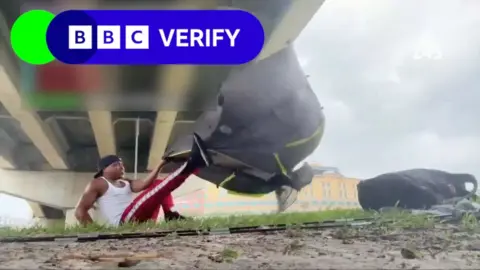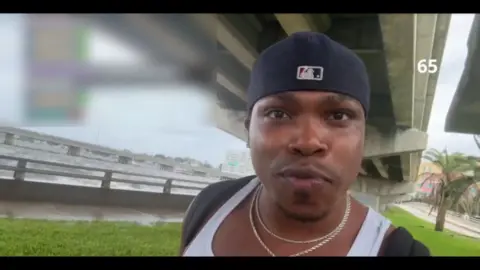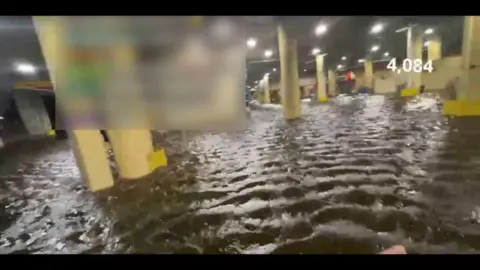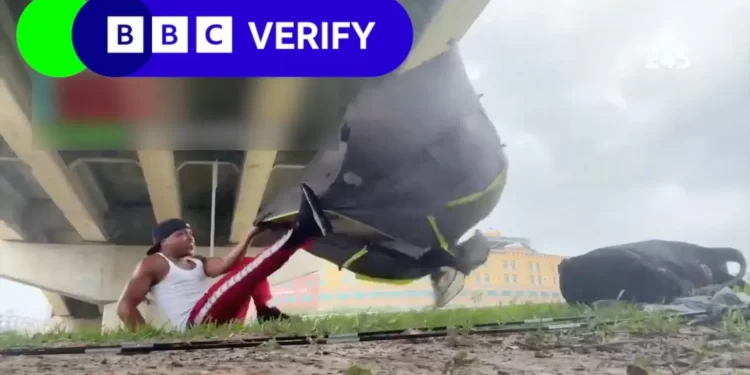 MikeSmallsJr
MikeSmallsJrWhile millions of people in Florida fled Hurricane Milton, Mike Smalls Jr ventured into the violent winds in Tampa, Florida, holding a blow-up mattress, an umbrella and a pack of ramen noodles.
He went outside Wednesday evening as the storm pounded the US state and livestreamed on the platform Kick. He told his online audience if he reached 10,000 views, he would launch himself and his mattress into the water.
Once he hit the threshold, he took the plunge. Then he got worried: “The wind started picking up and I don’t know how to swim…so I had to grab on to the tree.”
The area was under an evacuation order – meaning residents had been advised by local officials to leave their homes, for their own safety.
Mike’s hour-long stream from Tampa Bay has more than 60,000 views on the streaming platform Kick, and has been seen by millions after being clipped up and posted on other social-media platforms, including X.
Live streaming – filming yourself in real time – has become increasingly lucrative for content creators looking to make quick money.
But these streams can involve dangerous stunts, as content creators try to stand out in an increasingly competitive environment.
Many people have criticised Mike’s behaviour on social media, suggesting he’s risking his life for clicks.
He made it safely – and told me he’d do the risky stunt again, “if the price is right”.
When asked about the backlash, he admits what he did was “controversial” and acknowledges that some might think he is risking not just his life, but the lives of those who might have to save him. But, he added: “From a content creator standpoint, people like to see kind of edgy things.”
The Tampa Police Department said in a statement: “Ignoring mandatory evacuation orders puts lives at risk. When individuals disregard these warnings, they not only jeopardise their own safety, but also create additional challenges for first responders who are working tirelessly to save lives.
“Intentionally placing oneself in harm’s way could divert critical resources and delay vital rescue operations for others.”
Hundreds of people have died during this year’s hurricane season, which has devastated parts of the US south-eastern coast.
Millions had been forced to evacuate as Hurricane Milton, which at its peak was measured as a category 5 storm, made landfall on Wednesday along Florida’s Gulf Coast. At least 16 people have died in the storm, millions are still without power and thousands had to be rescued by first responders as water overtook homes.
Hurricanes Helene and Milton have bookended an exceptionally busy period of tropical weather in the US. In less than two weeks, five hurricanes formed – not far off from what the Atlantic would typically see during an entire year.
 Mike Smalls Jr
Mike Smalls JrMike is one of a number of content creators on social media platforms, including Kick and TikTok, who have been livestreaming and making money from pulling reckless stunts and risking their lives in hurricanes.
Livestreaming content is Mike’s full-time job, he says.
Previous stunts posted on his profile include setting fireworks off inside a bedroom and winding up staff in fast-food restaurants.
His plan for livestreaming Hurricane Milton was: “Get some nice clips, and then, if things get too wild, I can, just, you know, track my little five, 10-minute walk back home,” he added.
This wasn’t the first time he’d exposed himself to danger.
A few weeks before Milton struck, he went out into Hurricane Helene – which also hit Florida – carrying a tent as a prop and livestreamed for more than five hours.
He filmed himself on his phone holding up the tent in an underpass, saying he was “going to survive the hurricane. Why? To entertain the people”.
Just metres away, the ocean was crashing over barriers.
“It’s my job just to entertain and think of creative things to entertain my chat. And if people want to, you know, if they’re inspired by what I do, I respect it,” he said, adding you have to gauge and “do things at your own risk”.
Platforms like Kick offer incentives: money for the number of views streamers get and donations from people who like what they’re doing.
Smalls Jr did not specify how much money he earned from this particular livestream, but said the metrics vary from streamers, with some making $300 to $400 per hour. He added he made enough from his latest stream to pay a few bills.
 MikeSmallsJr
MikeSmallsJrIt might appear, Mike says, that he’s doing anything for views, but he says he takes safety very seriously. Despite not knowing how to swim, he insists that he assessed the risks.
He speaks with bravado after surviving the natural disaster: “I stayed here, and I didn’t die and I’m chilling.”
When asked to respond to specific questions on Smalls Jr and the platform’s responsibility, Kick said it is “a fiercely creator-first platform, and we do not influence the content our creators chose to stream. However, if that content breaches our Terms of Service, or is in any way illegal, then we can impose a ban or suspension”.
They did not comment when asked about whether Smalls Jr’s action breach their specific community guidelines which detail: “Safety First: Prioritise safety for yourself, your audience, the public and anyone else involved.”
TikTok told the BBC that their monetisation guidelines lay out how some content is not eligible to earn money through LIVE features, including “content that tricks or manipulates others… exploits controversial issues to bait engagement, or exploits the suffering of vulnerable people”.
Mike’s profile – and his hurricane content – is still available.
When asked about endangering the lives of emergency workers, Smalls Jr said he knows what he’s getting himself into.
“Don’t save me,” he said. “If I do another hurricane? All right. You ain’t got to say nothing. I do not want to put your life at risk. No.”








